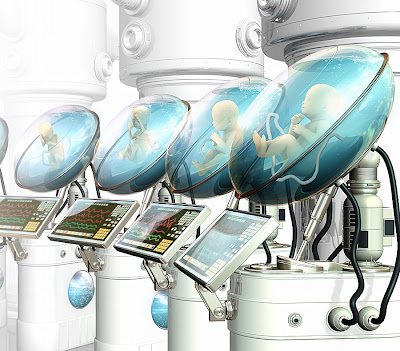 In my last SHS post, I deconstructed the “ethical” objections of “the scientists” to reproductive cloning as really being about safety, not the inherent wrongness of human cloning itself. (Reproductive cloning is actually a misnomer. The act of cloning is somatic cell nuclear transfer, which asexually creates an embryo. So what we are really talking about is the use to which the human life created through cloning would be put). Animal cloning leads to many miscarriages and birth defects, and thus there is near universal agreement that reproductive cloning should not be tried—for now.
In my last SHS post, I deconstructed the “ethical” objections of “the scientists” to reproductive cloning as really being about safety, not the inherent wrongness of human cloning itself. (Reproductive cloning is actually a misnomer. The act of cloning is somatic cell nuclear transfer, which asexually creates an embryo. So what we are really talking about is the use to which the human life created through cloning would be put). Animal cloning leads to many miscarriages and birth defects, and thus there is near universal agreement that reproductive cloning should not be tried—for now.
But if those problems could be overcome, I see no reason for believing that “the scientists” would still say no. In fact, is suspect they’d be tripping over each other to do it.
What would it take to make reproductive cloning “safe?” Scientists would have to repeatedly clone and destroy thousands and thousands of embryos and fetuses. I asked Dr. David Prentice for my book Consumer’s Guide to a Brave New World, what the process would likely be. From my book:
He [Prentice] described for me the intense research trial-and-error approach that would be required to learn how to safely engage in cloning-to-produce-children: “Scientists would have to clone thousands of embryos and grow them to the blastocyst stage to ensure that part of the process leading up to transfer into a uterus could be “safe,” monitoring and analyzing each embryo, destroying each one in the process. Next, cloned embryos would have to be transferred into the uteruses of women volunteers. The initial purpose would be analysis of development, not bringing the pregnancy to a live birth. Each of these clonal pregnancies would be terminated at various points of development, each fetus destroyed for scientific analysis. The surrogate mothers would also have to be closely monitored and tested, not only during the pregnancies but also for a substantial length of time after the abortions.
Finally, if these experiments demonstrated that it was probably safe to proceed, a few clonal pregnancies would be allowed to go to full term. Yet even then, the born cloned babies would have to be constantly monitored to determine whether any health problems develop. Each would have to be followed (and undergo a battery of tests both physical and psychological) for their entire lives, since there is no way to predict if problems [associated with gene expression] might arise later in childhood, adolescence, adulthood, or even into the senior years.”
The absurdity, not to mention the immorality, of treating human life as mere detritus to be experimented upon and tossed aside if it doesn’t have the proper (gene) consistency, should be self-evident. It would permit us to transform cloned human beings into life-long medical experiments. No wonder the President’s Council [on Bioethics] report was so unequivocal in its condemnation of attempting cloning-to-produce children!
Much of this work would probably be done in artificial wombs. But that wouldn’t change the nature of the sheer immorality of the experiments.
And consider this: If we reject human exceptionalism this becomes doable. For example, if purported “personhood” rather than “humanhood” comes to matter morally, scientist would be empowered to experiment on human fetuses—perhaps even infants—as much as they wanted and it wouldn’t matter.
Much is at stake in how we harness—and control—the awesome power of biotechnology. The principles we apply to determine what is ethical and what is not make all the difference in the world about the kind of society we will become.
Rome and the Church in the United States
Archbishop Michael J. Curley of Baltimore, who confirmed my father, was a pugnacious Irishman with a taste…
Marriage Annulment and False Mercy
Pope Leo XIV recently told participants in a juridical-pastoral formation course of the Roman Rota that the…
Undercover in Canada’s Lawless Abortion Industry
On November 27, 2023, thirty-six-year-old Alissa Golob walked through the doors of the Cabbagetown Women’s Clinic in…

